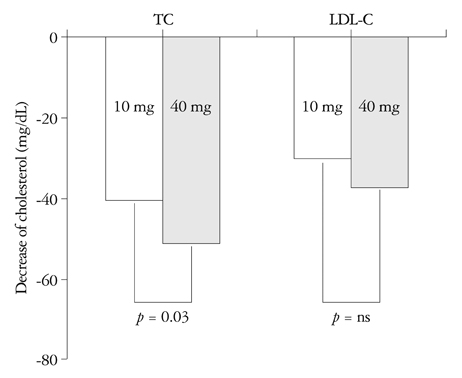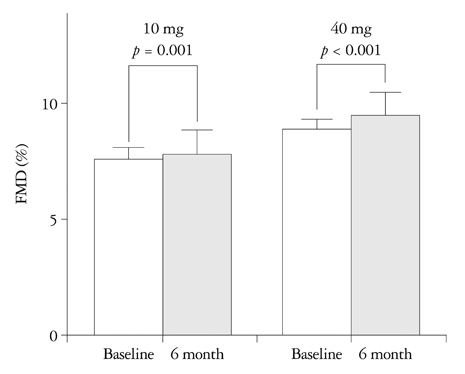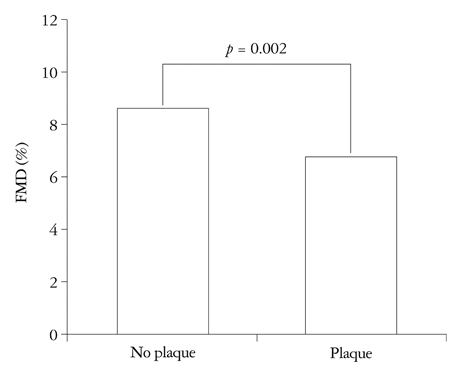J Cardiovasc Ultrasound.
2013 Jun;21(2):58-63.
Effects of Low Dose versus High Dose Statin Therapy on the Changes of Endothelial Function and Carotid Intima-Media Thickness in Patients with Variant Angina
- Affiliations
-
- 1The Heart Center of Chonnam National University Hospital, The Research Institute of Medical Sciences of Chonnam National University, Gwangju, Korea. jcpark54@hanmail.net
Abstract
- BACKGROUND
To compare the effects of low dose and high dose of statin treatment on endothelial function and carotid intima-media thickness (IMT) in patients with variant angina (VAP).
METHODS
A total of 70 patients with VAP were divided into two groups; atorvastatin 10 mg treatment group (group I: n = 35, 54.2 +/- 12.5 years) versus atorvastatin 40 mg treatment group (group II: n = 35, 52.6 +/- 9.8 years). Flow mediated vasodilation (FMD) of the brachial artery and IMT of the carotid artery were compared between the groups after 6 months of statin treatment.
RESULTS
The baseline FMD and carotid IMT were not different between the groups. After 6 months of statin therapy, FMD was significantly improved in both groups (7.7 +/- 2.5% to 8.9 +/- 2.2% in group I, p = 0.001, 7.9 +/- 2.7% to 9.5 +/- 2.8% in group II, p < 0.001), but the degree of FMD change and FMD at 6 month were not different between the groups. Carotid IMT were not changed in both groups after 6 months of statin therapy.
CONCLUSION
The use of statin for 6 months significantly improved endothelial function in patients with VAP, but carotid IMT was not changed. The use of high dose statin did not show significant additional benefit as compared with the use of low dose statin. The present study suggested that statin therapy would be beneficial in the treatment of VAP.
MeSH Terms
Figure
Reference
-
1. Yasue H, Nakagawa H, Itoh T, Harada E, Mizuno Y. Coronary artery spasm--clinical features, diagnosis, pathogenesis, and treatment. J Cardiol. 2008; 51:2–17.
Article2. Teragawa H, Kato M, Kurokawa J, Yamagata T, Matsuura H, Chayama K. Endothelial dysfunction is an independent factor responsible for vasospastic angina. Clin Sci (Lond). 2001; 101:707–713.
Article3. Cho SH, Jeong MH, Park IH, Choi JS, Yoon HJ, Kim KH, Hong YJ, Park HW, Kim JH, Ahn Y, Cho JG, Park JC, Kang JC. Endothelial dysfunction, increased carotid artery intima-media thickness and pulse wave velocity, and increased level of inflammatory markers are associated with variant angina. J Cardiol. 2009; 54:183–191.
Article4. Corretti MC, Anderson TJ, Benjamin EJ, Celermajer D, Charbonneau F, Creager MA, Deanfield J, Drexler H, Gerhard-Herman M, Herrington D, Vallance P, Vita J, Vogel R. International Brachial Artery Reactivity Task Force. Guidelines for the ultrasound assessment of endothelial-dependent flow-mediated vasodilation of the brachial artery: a report of the International Brachial Artery Reactivity Task Force. J Am Coll Cardiol. 2002; 39:257–265.
Article5. Nam CW, Kim GS, Lee SJ, Lee IG. Evaluation of endothelial function using high-resolution ultrasound in normal subjects: endothelial function according to aging. J Korean Soc Echocardiogr. 2000; 8:71–77.
Article6. Yamagishi M, Miyatake K, Tamai J, Nakatani S, Koyama J, Nissen SE. Intravascular ultrasound detection of atherosclerosis at the site of focal vasospasm in angiographically normal or minimally narrowed coronary segments. J Am Coll Cardiol. 1994; 23:352–357.
Article7. Randomised trial of cholesterol lowering in 4444 patients with coronary heart disease: the Scandinavian Simvastatin Survival Study (4S). Lancet. 1994; 344:1383–1389.8. Downs JR, Clearfield M, Weis S, Whitney E, Shapiro DR, Beere PA, Langendorfer A, Stein EA, Kruyer W, Gotto AM Jr. Primary prevention of acute coronary events with lovastatin in men and women with average cholesterol levels: results of AFCAPS/TexCAPS. Air Force/Texas Coronary Atherosclerosis Prevention Study. JAMA. 1998; 279:1615–1622.
Article9. The Long-Term Intervention with Pravastatin in Ischaemic Disease (LIPID) Study Group. Prevention of cardiovascular events and death with pravastatin in patients with coronary heart disease and a broad range of initial cholesterol levels. N Engl J Med. 1998; 339:1349–1357.10. Heart Protection Study Collaborative Group. MRC/BHF Heart Protection Study of cholesterol lowering with simvastatin in 20,536 high-risk individuals: a randomised placebo-controlled trial. Lancet. 2002; 360:7–22.11. Merten M, Dong JF, Lopez JA, Thiagarajan P. Cholesterol sulfate: a new adhesive molecule for platelets. Circulation. 2001; 103:2032–2034.12. Lacoste L, Lam JY, Hung J, Letchacovski G, Solymoss CB, Waters D. Hyperlipidemia and coronary disease. Correction of the increased thrombogenic potential with cholesterol reduction. Circulation. 1995; 92:3172–3177.13. Ridker PM, Rifai N, Pfeffer MA, Sacks FM, Moye LA, Goldman S, Flaker GC, Braunwald E. Cholesterol and Recurrent Events (CARE) Investigators. Inflammation, pravastatin, and the risk of coronary events after myocardial infarction in patients with average cholesterol levels. Circulation. 1998; 98:839–844.
Article14. Dupuis J, Tardif JC, Cernacek P, Théroux P. Cholesterol reduction rapidly improves endothelial function after acute coronary syndromes. The RECIFE (reduction of cholesterol in ischemia and function of the endothelium) trial. Circulation. 1999; 99:3227–3233.
Article15. Strandberg TE, Vanhanen H, Tikkanen MJ. Effect of statins on C-reactive protein in patients with coronary artery disease. Lancet. 1999; 353:118–119.
Article16. Yun KH, Shin IS, Park EM, Rhee SJ, Lee EM, Yoo NJ, Kim NH, Oh SK, Jeong JW. Effect of additional statin therapy on endothelial function and prognosis in patients with vasospastic angina. Korean Circ J. 2008; 38:638–643.
Article17. Walling A, Waters DD, Miller DD, Roy D, Pelletier GB, Théroux P. Long-term prognosis of patients with variant angina. Circulation. 1987; 76:990–997.
Article18. Mancini GB, Henry GC, Macaya C, O'Neill BJ, Pucillo AL, Carere RG, Wargovich TJ, Mudra H, Lüscher TF, Klibaner MI, Haber HE, Uprichard AC, Pepine CJ, Pitt B. Angiotensin-converting enzyme inhibition with quinapril improves endothelial vasomotor dysfunction in patients with coronary artery disease. The TREND (Trial on Reversing ENdothelial Dysfunction) Study. Circulation. 1996; 94:258–265.
Article19. Anderson TJ, Elstein E, Haber H, Charbonneau F. Comparative study of ACE-inhibition, angiotensin II antagonism, and calcium channel blockade on flow-mediated vasodilation in patients with coronary disease (BANFF study). J Am Coll Cardiol. 2000; 35:60–66.
Article20. Kim KH, Jeong MH, Cho SH, Moon JY, Hong YJ, Park HW, Kim JH, Ahn Y, Cho JG, Park JC, Kang JC. Clinical effects of calcium channel blocker and Angiotensin converting enzyme inhibitor on endothelial function and arterial stiffness in patients with angina pectoris. J Korean Med Sci. 2009; 24:223–231.
Article21. Lee YS, Kim KS. The short-term effect of atorvastatin on flow-mediated vasodilation, pulse wave velocity and carotid intima-media thickness in patients with moderate cholesterolemia. Korean Circ J. 2008; 38:144–151.
Article22. Reriani MK, Dunlay SM, Gupta B, West CP, Rihal CS, Lerman LO, Lerman A. Effects of statins on coronary and peripheral endothelial function in humans: a systematic review and meta-analysis of randomized controlled trials. Eur J Cardiovasc Prev Rehabil. 2011; 18:704–716.
Article23. Liu B, Zhang JY, Cao HM, Wang Q, Wang HB. Effect of rosuvastatin on ROCK activity, endothelial function, and inflammation in Asian patients with atherosclerosis. Intern Med. 2012; 51:1177–1182.
Article24. Zhang L, Gong D, Li S, Zhou X. Meta-analysis of the effects of statin therapy on endothelial function in patients with diabetes mellitus. Atherosclerosis. 2012; 223:78–85.
Article25. Ubels FL, Muntinga JH, van Doormaal JJ, Reitsma WD, Smit AJ. Effects of initial and long-term lipid-lowering therapy on vascular wall characteristics. Atherosclerosis. 2001; 154:155–161.
Article26. Kastelein JJ, Wiegman A, de Groot E. Surrogate markers of atherosclerosis: impact of statins. Atheroscler Suppl. 2003; 4:31–36.
Article27. Kang S, Wu Y, Li X. Effects of statin therapy on the progression of carotid atherosclerosis: a systematic review and meta-analysis. Atherosclerosis. 2004; 177:433–442.
Article28. Kastelein JJ, de Groot E, Sankatsing R. Atherosclerosis measured by B-mode ultrasonography: effect of statin therapy on disease progression. Am J Med. 2004; 116:Suppl 6A. 31S–36S.
Article29. Gibbons GH. Endothelial function as a determinant of vascular function and structure: a new therapeutic target. Am J Cardiol. 1997; 79:3–8.
Article30. Selwyn AP, Kinlay S, Creager M, Libby P, Ganz P. Cell dysfunction in atherosclerosis and the ischemic manifestations of coronary artery disease. Am J Cardiol. 1997; 79:17–23.
Article
- Full Text Links
- Actions
-
Cited
- CITED
-
- Close
- Share
- Similar articles
-
- The Short-term Effect of Atorvastatin on Flow-Mediated Vasodilation, Pulse Wave Velocity and Carotid Intima-Media Thickness in Patients With Moderate Cholesterolemia
- Do we need individual measurement of carotid intima and media thickness?
- Carotid ultrasound in patients with coronary artery disease
- Response: Increased Carotid Intima-Media Thickness Is Associated with Progression of Diabetic Nephropathy in Patients with Type 2 Diabetes
- Letter: Increased Carotid Intima-Media Thickness Is Associated with Progression of Diabetic Nephropathy in Patients with Type 2 Diabetes




